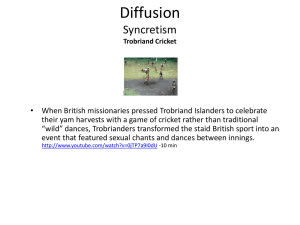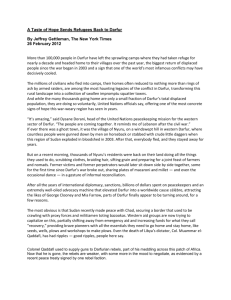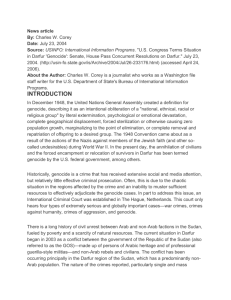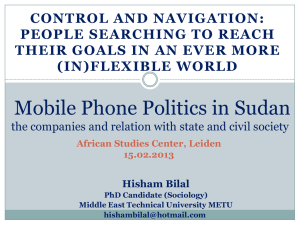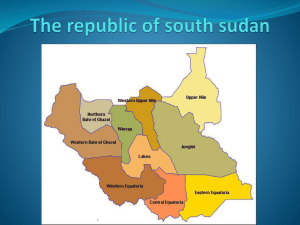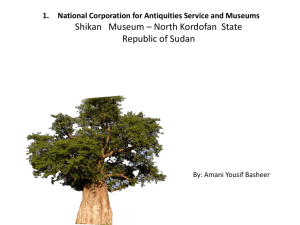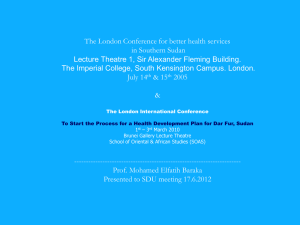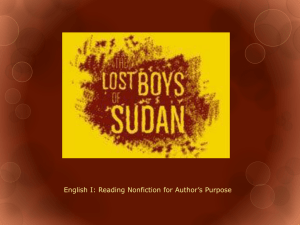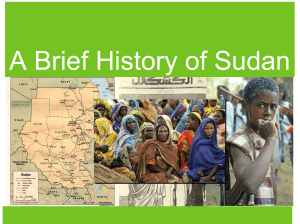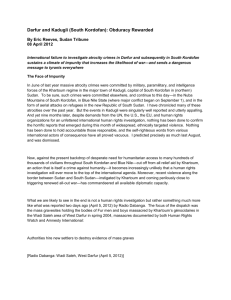Sudanese Civil War and the Conflict in Darfur
advertisement
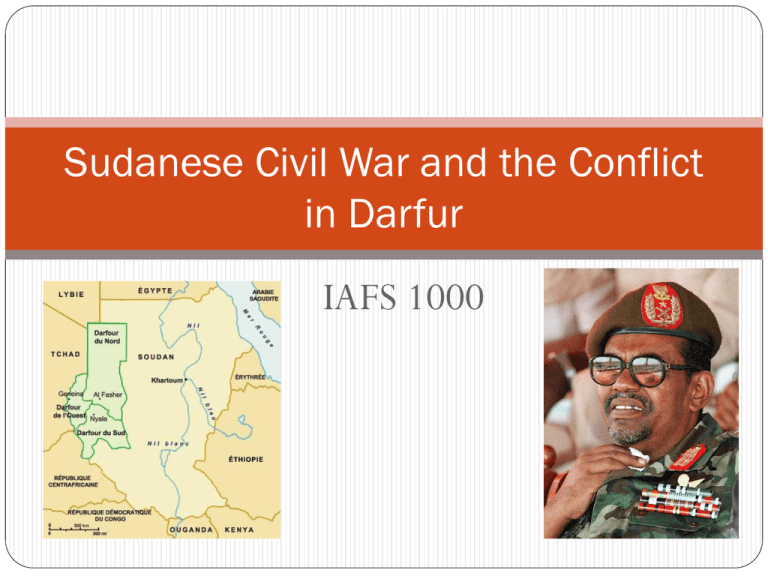
Sudanese Civil War and the Conflict in Darfur IAFS 1000 Sudan at a Glance • Was 10th largest state, largest in Africa • Red Sea coastline, Sahara desert, tropical south • Confluence of Blue Nile and White Nile • Capital: Khartoum Sudanese Population • Population: – 41 million – Concentrated in Khartoum, Darfur, South • Density: – 42/sq. mile • Urbanization: – 43% The Distant Past Sudan was once home to Nubia, a great empire of black Africans that rivaled the Egyptians. Nubia collapsed long ago and black Africans were pushed south by Arabs. Important to Southern claims to Sudan. “Land of Islam” Islam spread to the area of northern Sudan in the seventh century. North Sudanese adopted Islam and reorganized politics around Islam Proximate to Egypt, close relations with Middle East “Land of Islam” Khartoum became an important trading hub Slave traders were based in the north and went south on raids Ottomans conquered the area in 1820s “Land of War” Muslim jihadists failed to spread Islam to the south. South Sudan called “Land of War.” South raided for slaves, but avoided occupation Mahdi and Northern Nationalism The “Mahdi” led a resistance against the Ottomans in the late 19th century. Used Islamic propaganda to unify Sudan British Reconquest Britain helped Egypt defeat the Mahdiyah to return Sudan to Egyptian rule. Colonial institutions established in the north. Rule through local leaders and Christian missionaries in the south. The Sudanese Civil War(s) Independence • 1954: Britain and Egypt sign accord that states a united Sudan will become independent in 1956. • 1955: Anticipating independence, southern military leaders mutiny, initiate conflict against north. • 1956: Sudan becomes a sovereign state, and joins Arab League same month. Rebel Leadership and In-Group Policing Many peace accords failed because the rebels had no authentic leader. No leader could maintain any peace agreement. It was not until 1969 that Joseph Lagu was accepted as the authentic leader of the south. The “First Sudanese Civil War” 1955 – 1969: Early Northern leaders pursued peace via “Sudanization” (Islamization). 1969: Military coup led by Nimeiri, who pursues socialism rather than Islamization 1972: Nimeiri offers South regional autonomy, allies with the West and Egypt. 500,000 killed (1955 – 1972). Inter-War Years (1972 – 1983) 1970s: Nimeiri survives multiple attempted coups, enjoys support of southern leaders. 1978: Chevron discovers oil in the south. Return to War The North responds to discovery of oil by withdrawing autonomy granted to South and taking control of the oil fields. Nimeiri’s most important ally, Egyptian leader Sadat dies (1981). The regime weakens, Libya aids a coup that ousts Nimeiri in 1985. There Will Be Blood Oil fields (gray boxes) concentrated in South. Oil separated from north by Nuba Mountains. Short-Lived “Democracy” Following the coup, an election brings al-Mahdi (grandson of Mahdi) to power. No votes cast in the south. 1989: al-Bashir takes power in coup The SPLA The SPLA was formed by a group of military officers led by John Garang. Educated in Iowa, personal friend of Ugandan President Museveni. Child Soldiers 1990s The SPLA held the south and international support for SPLA grew to include the United States. Osama bin Laden and al Qaeda relocate to Sudan in 1991. Sudan began exporting oil in 1999. Comprehensive Peace Agreement The CPA (2005) Created democracy with elections every five years Grants power-sharing al-Bashir made President Garang made Vice President 50/50 revenue-sharing Causes of concern Garang dies in helicopter crash two weeks after he is made VP. War in Darfur complicates peace with South. Leaders have reneged on southern autonomy in the past. South would vote to secede or remain in Sudan in 2010/11. SPLA allowed to maintain army until 2011 Islamic law discontinued in South. The War in Darfur Darfur is the western region of Sudan. Dry with arable land Extremely isolated LAND OF THE FUR… People of Darfur Arab (40%) Fur (25%) Masalit (12%) Zaghawa (9%) Others (14%) DIVERSITY AND SALIENCE IN DARFUR The people of Darfur, both Arab and non-Arab, are predominantly Muslim. The most important difference between Arabs and non-Arabs in Darfur: Arabs: Predominantly nomadic, use arable land for grazing Non-Arabs: Predominantly farmers, live permanently on arable land. HISTORY OF DARFUR Independent Darfur Sultanate until Egyptian invasion in 1870s. Multi-ethnic feudal state. Major power in Sahara, dominated trade Joined Mahdi movement against Egypt in 1880s. ANGLO-EGYPTIAN RULE After the Mahdi regime was defeated by the British and Egyptians (1890s), the British decided Darfur was too isolated to be part of Sudan. The British decided to include Darfur in Sudan in 1916. Like South Sudan, Darfur was ruled locally. DARFUR AND INDEPENDENT SUDAN Darfur was a strong region for the Mahdi party that favored isolationism and Islamist rule. Darfur distrusted Egypt and the Arabs running the country in Khartoum. Impartial in South Sudanese civil war. Leaders from Darfur disliked both sides. DARFUR AND NIMEIRI Nimeiri came to power in 1969, turned away from Islamization Darfur offered cross border sanctuary for Islamists in Chad. Qaddafi supported an Islamist movement against Nimeiri in Darfur. FAMINE AND FAILURE Famine Famine, desertification increase tension between Arab herders and non-Arab farmers. Regime Failure al-Bashir, an Islamist, comes to power in 1989. As government support for “Janjaweed” form, attack farmers to claim land for herders janjaweed increases, rebel groups form to defend farmers. JEM & SLM Justice and Equality Movement Sudan Liberation Movement Created by non-Arab Created by local Zaghawa Islamists purged from alBashir’s regime. and Fur leaders in Darfur. Divided into three major Founded by author of “Black Book,” which used government statistics to show relative deprivation. factions along ethnic lines. The War Begins (2003) •JEM/SLA attack government • Government responds by giving janjaweed weapons, air support. •300K to 500k killed, most Darfuri civilians • 2.7 million refugees; 1/3 of Darfuris displaced INTERNATIONAL INFLUENCE China continues to support the al-Bashir regime with investment, arms trades, and support in the UN Security Council. Genocide Bush Administration al-Bashir charged with war crimes by ICC in 2009. Countdown to Independence for South Sudan – “The world’s newest nation” July 2009 Both parties agree to allow The Hague to determine border demarcation. April 2010 First elections since CPA, Garang’s death January 2011 The South votes to secede from Sudan Oil now accounts for 70% of Sudan’s export revenue Infrastructure remains undeveloped away from Khartoum, Port Sudan Independent South Sudan 2011 98.85 of citizens approved independence by referendum Salva Kiir Mayardit, a Dinka, the first President of South Sudan. Civil War………Again 2014 Vice President and now opposition Leader, Dr. Riek Machar, a Nuer Lenses for Understanding these Conflicts The Resource Curse Used by Political Scientists, Economists, and Geographers minerals and fuels less economic growth and worse development outcomes What the …? Decline in the competitiveness of other sectors Volatility associated with market swings Government mismanagement of resources Weak/unstable political/economic institutions Public Goods Distribution Used by Political Scientists and Economists “Exporting Colonial Institutions” Used by Political Scientists, Geographers and Economists Should I stay or should I go? Colonizers weren’t fans of malaria… Exoticism of culture Colonial Legacy Extractive institutions Integrated institutions Social Psychology Theories Intergroup Contact Theory Casual, impersonal contacts encourage hostile stereotyping Prolonged, personal contacts lessen discrimination Social Identity Theory Ingroup – outgroup comparisons Positive social distinctiveness for ingroup

